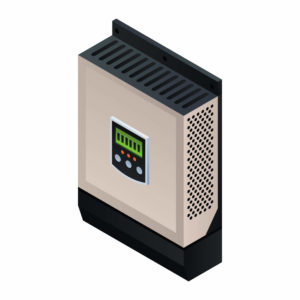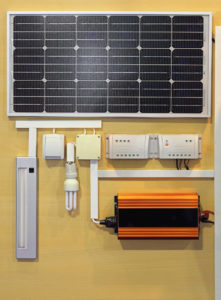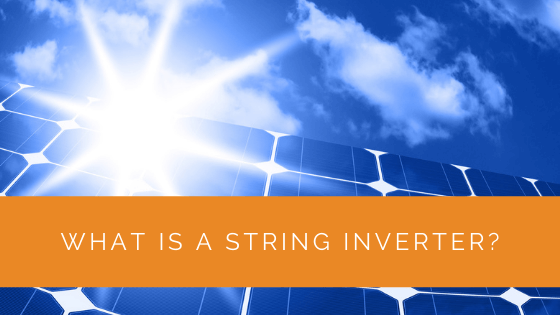Inverters are an integral part of any solar power system. Basically, these components convert the DC power output of the solar panels into AC power that can power regular domestic, commercial and industrial electrical appliances and equipment.
Inverters also play a huge role in optimizing the performance of solar panel systems. String inverters are among the most popular types of inverters available today, thanks to their affordable, durable and reliable nature.
Technological advancements in the design and manufacturing of these inverters have led to major improvements in their performance. Today’s string inverters offer better performance and efficiency than their older counterparts.
To find out more about string inverters, including what they are, how they work, and how they compare with other types of inverters, read on below.
Contents
- 1 Key Takeaways
- 2 What Is a String Inverter?
- 3 How Does a String Inverter Work?
- 4 What Are the Benefits of String Inverters?
- 5 String Inverters Vs. Microinverters Vs. Optimizers
- 6 Case Study: Enhancing Solar System Efficiency with String Inverters
- 7 Expert Insights From Our Solar Panel Installers About String Inverters
- 8 Experience Solar Excellence with Us!
- 9 Conclusion
Key Takeaways
- String inverters are essential components in solar power systems that convert DC power from solar panels into AC power for everyday use in homes and businesses.
- String inverters are known for their affordability, reliability, and suitability for applications with minimal shading issues. They have a long history of successful use in solar panel systems.
- While string inverters offer advantages like cost-effectiveness and ease of diagnosis, they may not be the best choice for applications with significant shading. Alternatives like microinverters and optimizers offer more efficient solutions for such scenarios.
What Is a String Inverter?
String inverters bring together all the DC output of the solar panels in your set up into strings, feeding into one inverter. All the DC power flowing from the entire array of solar panels is then converted into AC power by this single inverter.
In most cases, the centrally mounted inverter is placed in your home’s electrical panel box – typically located in the garage or on the side of your house.
Arguably the oldest type of inverters available out there, string inverters were initially suited for use in applications with minimal shading issues.
However, improvements in the efficiency and performance of these inverters have led to increased use in a wider variety of applications. As it stands, when used in the most suitable applications, these inverters are highly reliable and durable.
How Does a String Inverter Work?
Groups of solar panels feeding DC power into a string inverter are connected into several strings through a series connection. Several strings of panels can be connected to a string inverter without any issue.
For instance, if you have a system composed of 15 solar panels, they can be separated into three separate strings – of five individual panels each connected in series – feeding into the central inverter.
In practice, the number of solar panels that can be connected to a string inverter depends on the input voltage rating of the inverter and the output voltage rating of the solar panels.
Since the solar panels are connected in series, any productivity dip in any of the panels in a string will have an equally negative effect on the total output of the entire string.
In simpler terms, the inverter normally caps the total output of a string to that of the panel with the lowest output in that string. As such, these inverters are best suited to applications where the solar panels are affected by minimal or no shading at all.

What Are the Benefits of String Inverters?
In the right application, string inverters are an affordable, reliable and highly efficient option. They have become the most commonly featured type of inverter in domestic solar panel systems over the years.
Here are some of the main reasons why you might want to consider this type of inverter when setting up your solar panel system:
A Reliable Option
String inverters are very reliable. This is one of the main reasons why they have withstood the test of time to become one of today’s most popular inverters for solar panel systems.
For many years, string inverters were the only available option for solar panel users. And, as such, they are based on technology that has been tried and tested successfully for many years.
Affordable
Since you can link an entire solar array, made up of numerous solar panels, to a single inverter, string inverters are considered a highly affordable option.
Furthermore, installing a single inverter in a solar panel system also translates into lower installation costs. Fewer labor hours and less wiring are needed to link the solar panels to the inverter before connecting to your property’s electrical circuit.
Easily Diagnose Issues
Solar panels are built to serve owners/users for many years to come. And when it comes to solar power supply systems, the component that is most likely to fail, or encounter issues, is the inverter. With that in mind, it is important to note that it is easier for users and technicians to troubleshoot and diagnose issues in systems equipped with one inverter.
Fewer Wiring Issues
It is worth noting that the use of string inverters also helps reduce any issues related to improper wiring of the solar power system. Through grouping of panels into strings, string inverters reduce and simplify the nature of the wiring involved.
String Inverters Vs. Microinverters Vs. Optimizers
While string inverters are a great option, they may not be a perfect fit for some applications. In such cases, alternatives such as microinverters or even optimizers may be better suited. To help make the work of choosing the best option from these three alternatives easier, it’s helpful to know how they compare with each other.
String Inverters
The appeal of string inverters is quite clear at this point. However, their associated drawbacks also make them unsuitable for some applications. As previously stated, these inverters normally cap the output of each string of solar panels to the lowest individual output of the panels in the string.
While technological advancements have gone a long way towards improving the efficiency of these inverters, their use is generally suited to applications where shading is minimal.

Microinverters
Unlike the string variety, microinverters work to convert the DC output from solar panels differently. To convert DC power into AC power, each solar panel is connected to its own microinverter, in parallel.
While some microinverters may be designed to work with up to four solar panels at once, using these inverters usually means that the number of inverters should match those panels in a solar array.
By converting the output of each panel separately, microinverters help optimize the performance of the overall system, regardless of individual solar panel output levels. Furthermore, with microinverters, it is possible to monitor the performance of individual solar panels in a solar array – something that is not possible with string inverters.
However, the use of more inverters ultimately increases the likelihood of something going wrong – in terms of inverter failure or wiring issues. On top of this, the installation of microinverters is more demanding and costlier than that of string inverters.
Optimizers
Considered to be a compromise between microinverters and string inverters, optimizers generally have the same benefits (and drawbacks) as microinverters.
Simply put, optimizers are designed to be mounted on individual solar panels. While they do not actually convert the panel’s DC output to AC, they are designed to condition the output before sending it through to a central inverter – string inverter.
The output optimization capabilities of optimizers can help boost the efficiency of a solar power system to levels higher than what is possible with a string inverter alone.
Case Study: Enhancing Solar System Efficiency with String Inverters
Background
At Solar Panels Network USA, we focus on delivering optimized solar solutions tailored to our clients’ specific needs. This case study highlights the application of string inverters in a residential solar power system, showcasing their efficiency and reliability in the right conditions.
Project Overview
Our client, a homeowner looking to reduce their energy costs and carbon footprint, wanted to install a solar power system on their property. Given the layout of the property and minimal shading, string inverters were identified as the most suitable solution.
Implementation
We began with a comprehensive site assessment to determine the optimal placement of the solar panels and the central inverter. The assessment included evaluating shading patterns, roof angles, and the electrical needs of the home.
Detailed Process
System Design and Planning: The system was designed to include 20 solar panels, divided into four strings of five panels each. These strings were connected to a single, centrally located string inverter installed in the garage. This setup ensured minimal shading impact and maximized efficiency.
Installation: The solar panels were installed on the south-facing roof, ensuring maximum sun exposure. The string inverter was mounted securely in the garage, with all electrical connections carefully configured to optimize performance.
Optimization and Testing: After installation, the system underwent rigorous testing to ensure all components functioned correctly. The string inverter’s performance was monitored closely to verify that it was converting the DC power from the solar panels into AC power efficiently.
Maintenance and Monitoring
A maintenance schedule was established to keep the system running smoothly:
Regular Inspections: Periodic inspections were conducted to check for any signs of wear, damage, or debris on the panels and inverter. This proactive approach helped in identifying potential issues early.
Performance Monitoring: The system’s performance was continuously monitored using a dedicated monitoring tool. This allowed the homeowner to track energy production and usage, ensuring the system was operating at peak efficiency.
Results
The implementation of the string inverter-based system resulted in significant energy savings for the homeowner. The system generated enough electricity to cover approximately 80% of the household’s energy needs, leading to a substantial reduction in utility bills. Additionally, the homeowner reported no significant performance issues, confirming the reliability of the string inverter in this setup.
Summary
This case study illustrates the effectiveness of string inverters in solar power systems with minimal shading. By carefully assessing the site and designing the system to leverage the strengths of string inverters, we achieved high efficiency and reliability. Regular maintenance and monitoring further ensured the long-term performance of the system, providing the homeowner with a sustainable and cost-effective energy solution.
Expert Insights From Our Solar Panel Installers About String Inverters
String inverters are a cornerstone of many solar power systems due to their cost-effectiveness and reliability. They convert the DC power from multiple solar panels into AC power, making it usable for homes and businesses.
Senior Solar Installer
While string inverters are highly efficient for installations with minimal shading, they may not be suitable for all environments. Alternatives like microinverters and optimizers can offer better performance in areas with significant shading.
Lead Solar Technician
Regular maintenance and monitoring of string inverters can help identify and resolve issues quickly, ensuring the long-term efficiency of the solar power system.
Solar System Engineer
Experience Solar Excellence with Us!
Trust in Solar Panels Network USA, where our seasoned experts deliver top-quality solar solutions for homes and businesses nationwide. With a legacy of countless successful installations and a commitment to sustainable energy, we’re your reliable partner in the solar journey. Ready for a brighter, eco-friendly future? Call us now at (855) 427-0058 and harness the power of the sun!
Conclusion
String inverters are a reliable and affordable option for property owners looking to install a solar power system. And with an average lifespan of anywhere between 8 and 12 years, they are also quite durable.
However, they are still not as efficient as some of the newer alternatives when used in solar panel systems where shading is a serious issue.
About the Author
Solar Panels Network USA stands at the forefront of solar energy solutions, driven by a team of seasoned solar engineers and energy consultants. With over decades of experience in delivering high-quality solar installations and maintenance, we are committed to promoting sustainable energy through customer-centric, tailored solutions. Our articles reflect this commitment, crafted collaboratively by experts to provide accurate, up-to-date insights into solar technology, ensuring our readers are well-informed and empowered in their solar energy decisions.

